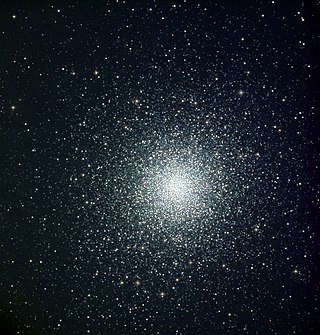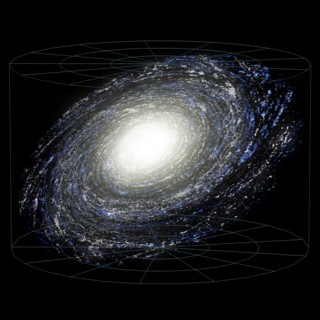Related Research Articles

A globular cluster is a spheroidal conglomeration of stars that is bound together by gravity, with a higher concentration of stars towards their centers. They can contain anywhere from tens of thousands to many millions of member stars, all orbiting in a stable, compact formation. Globular clusters are similar in form to dwarf spheroidal galaxies, and the distinction between the two is not always clear. Their name is derived from Latin globulus. Globular clusters are occasionally known simply as "globulars".

The Local Group is the galaxy group that includes the Milky Way. It has a total diameter of roughly 3 megaparsecs (10 million light-years; 9×1019 kilometres), and a total mass of the order of 2×1012 solar masses (4×1042 kg). It consists of two collections of galaxies in a "dumbbell" shape; the Milky Way and its satellites form one lobe, and the Andromeda Galaxy and its satellites constitute the other. The two collections are separated by about 800 kiloparsecs (3×106 ly; 2×1019 km) and are moving toward one another with a velocity of 123 km/s. The group itself is a part of the larger Virgo Supercluster, which may be a part of the Laniakea Supercluster. The exact number of galaxies in the Local Group is unknown as some are occluded by the Milky Way; however, at least 80 members are known, most of which are dwarf galaxies.

Star clusters are large groups of stars held together by self-gravitation. Two main types of star clusters can be distinguished: globular clusters are tight groups of ten thousand to millions of old stars which are gravitationally bound, while open clusters are more loosely clustered groups of stars, generally containing fewer than a few hundred members, and are often very young. Open clusters become disrupted over time by the gravitational influence of giant molecular clouds as they move through the galaxy, but cluster members will continue to move in broadly the same direction through space even though they are no longer gravitationally bound; they are then known as a stellar association, sometimes also referred to as a moving group.

Spiral galaxies form a class of galaxy originally described by Edwin Hubble in his 1936 work The Realm of the Nebulae and, as such, form part of the Hubble sequence. Most spiral galaxies consist of a flat, rotating disk containing stars, gas and dust, and a central concentration of stars known as the bulge. These are often surrounded by a much fainter halo of stars, many of which reside in globular clusters.

The Sagittarius Dwarf Spheroidal Galaxy (Sgr dSph), also known as the Sagittarius Dwarf Elliptical Galaxy, is an elliptical loop-shaped satellite galaxy of the Milky Way. It contains four globular clusters in its main body, with the brightest of them—NGC 6715 (M54)—being known well before the discovery of the galaxy itself in 1994. Sgr dSph is roughly 10,000 light-years in diameter, and is currently about 70,000 light-years from Earth, travelling in a polar orbit at a distance of about 50,000 light-years from the core of the Milky Way. In its looping, spiraling path, it has passed through the plane of the Milky Way several times in the past. In 2018 the Gaia project of the European Space Agency showed that Sgr dSph had caused perturbations in a set of stars near the Milky Way's core, causing unexpected rippling movements of the stars triggered when it moved past the Milky Way between 300 and 900 million years ago.

Omega Centauri is a globular cluster in the constellation of Centaurus that was first identified as a non-stellar object by Edmond Halley in 1677. Located at a distance of 17,090 light-years, it is the largest-known globular cluster in the Milky Way at a diameter of roughly 150 light-years. It is estimated to contain approximately 10 million stars, and a total mass equivalent to 4 million solar masses, making it the most massive-known globular cluster in the Milky Way.

Messier 2 or M2 is a globular cluster in the constellation Aquarius, five degrees north of the star Beta Aquarii. It was discovered by Jean-Dominique Maraldi in 1746, and is one of the largest known globular clusters.

A dwarf galaxy is a small galaxy composed of about 1000 up to several billion stars, as compared to the Milky Way's 200–400 billion stars. The Large Magellanic Cloud, which closely orbits the Milky Way and contains over 30 billion stars, is sometimes classified as a dwarf galaxy; others consider it a full-fledged galaxy. Dwarf galaxies' formation and activity are thought to be heavily influenced by interactions with larger galaxies. Astronomers identify numerous types of dwarf galaxies, based on their shape and composition.

Messier 79 is a globular cluster in the southern constellation Lepus. It was discovered by Pierre Méchain in 1780 and is about 42,000 light-years away from Earth and 60,000 light years from the Galactic Center.

The Fornax Dwarf Spheroidal is an elliptical dwarf galaxy in the constellation Fornax that was discovered in 1938 by Harlow Shapley. He discovered it while he was in South Africa on photographic plates taken by the 24 inch (61 cm) Bruce refractor at Boyden Observatory, shortly after he discovered the Sculptor Dwarf Galaxy.

The Monoceros Ring(monoceros: Greek for 'unicorn') is a long, complex, ring of stars that wraps around the Milky Way three times. This is proposed to consist of a stellar stream torn from the Canis Major Dwarf Galaxy by tidal forces as part of the process of merging with the Milky Way over a period of billions of years, although this view has long been disputed. The ring contains 100 million solar masses and is 200,000 light years long.

The Milky Way is the galaxy that includes the Solar System, with the name describing the galaxy's appearance from Earth: a hazy band of light seen in the night sky formed from stars that cannot be individually distinguished by the naked eye. The term Milky Way is a translation of the Latin via lactea, from the Greek γαλαξίας κύκλος, meaning "milky circle". From Earth, the Milky Way appears as a band because its disk-shaped structure is viewed from within. Galileo Galilei first resolved the band of light into individual stars with his telescope in 1610. Until the early 1920s, most astronomers thought that the Milky Way contained all the stars in the Universe. Following the 1920 Great Debate between the astronomers Harlow Shapley and Heber Doust Curtis, observations by Edwin Hubble showed that the Milky Way is just one of many galaxies.

A satellite galaxy is a smaller companion galaxy that travels on bound orbits within the gravitational potential of a more massive and luminous host galaxy. Satellite galaxies and their constituents are bound to their host galaxy, in the same way that planets within our own solar system are gravitationally bound to the Sun. While most satellite galaxies are dwarf galaxies, satellite galaxies of large galaxy clusters can be much more massive. The Milky Way is orbited by about fifty satellite galaxies, the largest of which is the Large Magellanic Cloud.

Interacting galaxies are galaxies whose gravitational fields result in a disturbance of one another. An example of a minor interaction is a satellite galaxy disturbing the primary galaxy's spiral arms. An example of a major interaction is a galactic collision, which may lead to a galaxy merger.

The Virgo Stellar Stream, also known as Virgo Overdensity, is the proposed name for a stellar stream in the constellation of Virgo which was discovered in 2005. The stream is thought to be the remains of a dwarf spheroidal galaxy that is in the process of merging with the Milky Way. It is the largest galaxy visible from the Earth, in terms of the area of the night sky covered.

Terzan 7 is a sparse and young globular cluster that is believed to have originated in the Sagittarius Dwarf Spheroidal Galaxy and is physically associated with it. It is relatively metal rich with [Fe/H] = -0.6 and an estimated age of 7.5 Gyr. Terzan 7 has low levels of nickel which supports its membership in the Sag DEG system since it has a similar chemical signature. It has a rich population of blue stragglers that are strongly concentrated toward the center of Terzan 7. It has an average luminosity distribution of Mv = -5.05. It has a half-light radius (Rh) of 6.5pc.

NGC 4147 is the New General Catalogue identifier for a globular cluster of stars in the northern constellation of Coma Berenices. It was discovered by English astronomer William Herschel on March 14, 1784, who described it as "very bright, pretty large, gradually brighter in the middle". With an apparent visual magnitude of 10.7, it is located around 60,000 light years away from the Sun at a relatively high galactic latitude of 77.2°.

NGC 5053 is the New General Catalogue designation for a globular cluster in the northern constellation of Coma Berenices. It was discovered by German-British astronomer William Herschel on March 14, 1784 and cataloged as VI-7. In his abbreviated notation, he described it as, "an extremely faint cluster of extremely small stars with resolvable nebula 8 or 10′ diameter, verified by a power of 240, beyond doubt". Danish-Irish astronomer John Louis Emil Dreyer reported in 1888 that the cluster appeared, "very faint, pretty large, irregular round shape, growing very gradually brighter at the middle".

The Gaia Sausage or Gaia Enceladus is the remains of a dwarf galaxy that merged with the Milky Way about 8–11 billion years ago. At least eight globular clusters were added to the Milky Way along with 50 billion solar masses of stars, gas and dark matter. It represents the last major merger of the Milky Way.
References
- 1 2 3 "NASA/IPAC Extragalactic Database". Results for Canis Major Dwarf. Retrieved 16 March 2007.
- ↑ "Astronomers find nearest galaxy to the Milky Way". Archived from the original on 27 May 2008. Retrieved 24 September 2009.
- 1 2 3 N. F. Martin; R. A. Ibata; M. Bellazzini; M. J. Irwin; G. F. Lewis; W. Dehnen (2004). "A dwarf galaxy remnant in Canis Major: the fossil of an in-plane accretion onto the Milky Way". Monthly Notices of the Royal Astronomical Society. 348 (12): 12. arXiv: astro-ph/0311010 . Bibcode:2004MNRAS.348...12M. doi:10.1111/j.1365-2966.2004.07331.x. S2CID 18383992.
- ↑ Maggie Masetti (14 April 2011). "The Nearest Galaxies". The Cosmic Distance Scale. NASA. Archived from the original on 26 November 2011. Retrieved 26 November 2011. See section "The Canis Major Dwarf".
- ↑ Lopez-Corredoira, M.; Moitinho, A.; Zaggia, S.; Momany, Y.; Carraro, G.; Hammersley, P. L.; Cabrera-Lavers, A.; Vazquez, R. A. (July 2012). "Comments on the "Monoceros" affair". arXiv: 1207.2749 [astro-ph.GA].
- ↑ Momany, Y.; Zaggia, S. R.; Bonifacio, P.; Piotto, G.; De Angeli, F.; Bedin, L. R.; Carraro, G. (July 2004). "Probing the Canis Major stellar over-density as due to the Galactic warp". Astronomy and Astrophysics. 421 (2): L29. arXiv: astro-ph/0405526 . Bibcode:2004A&A...421L..29M. doi:10.1051/0004-6361:20040183. S2CID 6371010.
- ↑ Mateu, Cecilia; Vivas, A. Katherina; Zinn, Robert; Miller, Lissa R.; Abad, Carlos (2009). "No Excess of RR Lyrae Stars in the Canis Major Overdensity". The Astronomical Journal. 37 (5): 4412–23. arXiv: 0903.0376 . Bibcode:2009AJ....137.4412M. doi:10.1088/0004-6256/137/5/4412. S2CID 18967866.
